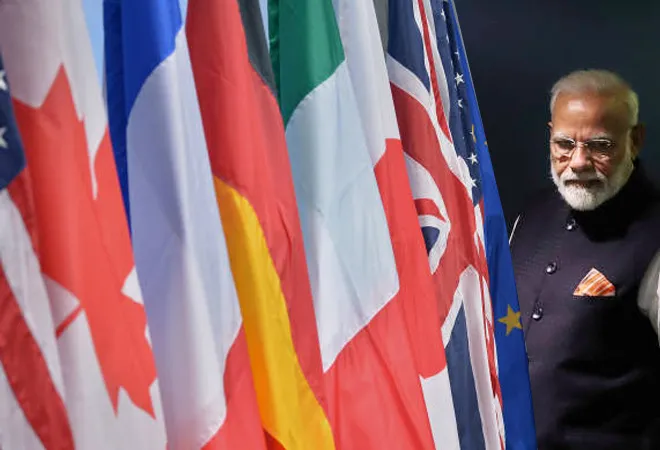Introduction: India’s Rising Star at the G7
The 51st G7 Summit, hosted in the scenic Kananaskis, Alberta, from June 16-17, 2025, marked a pivotal moment for India. As a guest nation, India, under Prime Minister Narendra Modi’s leadership, seized the global stage, reinforcing its role as an indispensable player in addressing pressing challenges like energy security, artificial intelligence (AI), and geopolitical tensions. Modi’s sixth consecutive G7 appearance underscored India’s growing influence, with his strategic diplomacy and focus on the Global South shaping discussions among the world’s leading democracies—Canada, France, Germany, Italy, Japan, the UK, and the US, alongside the European Union.
Modi’s Arrival: A Diplomatic Milestone

Modi’s visit to Canada, his first in a decade, was a significant diplomatic event, especially given recent strains in India-Canada relations. Tensions, fueled by Canada’s allegations of Indian involvement in the 2023 killing of Sikh activist Hardeep Singh Nijjar, had cast a shadow over bilateral ties. However, Canadian Prime Minister Mark Carney’s invitation to Modi signaled a thaw, driven by pressure from other G7 nations who recognize India’s economic and strategic importance. As Carney noted, India’s status as the fifth-largest economy and its central role in global supply chains made its presence at the summit essential. Modi’s arrival in Calgary on June 16, 2025, was met with optimism, with both leaders committing to rebuild ties based on mutual respect.
India’s Voice on Global Issues
At the G7, Modi articulated India’s priorities, balancing national interests with global responsibilities. His interventions focused on three key areas:
1. Energy Security and Climate Action
Modi emphasized the need for diversified energy sources and robust infrastructure to ensure global energy security. India’s rapid adoption of renewable energy—evidenced by its ambitious 500 GW non-fossil fuel capacity target by 2030—positioned it as a leader in the clean energy transition. Modi called for technology transfers and climate finance to support developing nations, aligning with the G7’s Energy for Growth in Africa initiative launched in 2024. His advocacy for the Global South resonated, highlighting the vulnerabilities of poorer nations to climate change and economic instability.
2. Technology and AI Innovation
The G7’s focus on AI regulation, through initiatives like the Hiroshima AI Process, provided Modi a platform to showcase India’s tech prowess. With India’s digital economy projected to reach $1 trillion by 2026, Modi stressed the importance of inclusive AI frameworks that prioritize ethical development and accessibility. He proposed collaboration on quantum computing and AI-driven solutions for agriculture and healthcare, reinforcing India’s role as a hub for innovation and a bridge between the Global North and South.
3. Geopolitical Stability
Amid escalating tensions in the Middle East and the ongoing Russia-Ukraine conflict, Modi advocated for dialogue and de-escalation. India’s multi-alignment policy—maintaining ties with both Western nations and Russia—enabled Modi to offer a nuanced perspective. He reiterated India’s support for a ceasefire in Gaza and a peaceful resolution in Ukraine, drawing on India’s humanitarian efforts like Operation Sindoor, which targeted terror infrastructure in Pakistan in 2025 without escalating regional conflict. Modi’s call for a rules-based international order aligned with G7 values, earning appreciation from leaders like Italy’s Giorgia Meloni and Japan’s Fumio Kishida.
Modi’s Bilateral Engagements: Resetting Ties
On the sidelines of the summit, Modi held crucial bilateral meetings, notably with Carney, to reset India-Canada relations. The leaders agreed to enhance law enforcement dialogue and explore trade opportunities, building on 2024’s $8.6 billion bilateral trade in goods and $14.3 billion in services. Modi’s discussions with US President Donald Trump addressed trade disputes, with India navigating US tariffs while advocating for fair global economic policies. Meetings with France’s Emmanuel Macron and the UK’s Keir Starmer strengthened defense and economic partnerships, with Modi securing commitments for deeper collaboration in the Indo-Pacific to counter China’s assertiveness.
India’s Economic Clout: Why the G7 Needs India

India’s economic ascent—projected to become the third-largest economy by 2027—made it a focal point at the summit. With a GDP of $4.3 trillion in 2025, up from $2.1 trillion a decade ago, India’s growth, driven by its IT sector, fintech, and domestic consumption, contrasts with China’s investment-heavy model. The G7’s interest in diversifying supply chains away from China, particularly for critical minerals and semiconductors, aligned with India’s strategic partnerships through the Quad (with the US, Japan, and Australia). As Vina Nadjibulla of the Asia Pacific Foundation of Canada noted, the G6’s push to include India reflected its indispensable role in global economic stability.
Challenges and Criticisms
Despite Modi’s diplomatic successes, challenges persisted. Canada’s Sikh community, particularly the World Sikh Organization, criticized Carney’s invitation, citing unresolved issues around Nijjar’s killing. Modi’s absence from earlier G7 speculation, as reported by some Indian media, fueled debates about India’s strained ties with Canada. Critics also questioned the G7’s relevance, arguing that the G20, which includes India as a full member, better reflects today’s multipolar world. However, Modi’s ability to navigate these criticisms while amplifying India’s voice demonstrated his diplomatic acumen.
Modi’s Vision for the Global South
Modi’s emphasis on the Global South—home to much of the world’s impoverished population—set him apart at the G7. Drawing on India’s G20 presidency in 2023, themed “One Earth, One Family, One Future,” he advocated for inclusive governance and equitable access to resources. His call for reforming outdated global institutions, like the UN Security Council, echoed India’s quest for a permanent seat, aligning with the G7’s commitment to a rules-based order. Modi’s leadership in initiatives like the Vaccine Maitri program during the COVID-19 pandemic further cemented India’s role as a reliable partner for developing nations.
Conclusion: Modi’s Lasting Impact
The G7 Summit 2025 was a defining moment for India, with Modi shaping global leadership through strategic diplomacy and a vision for inclusive growth. His ability to bridge divides—between the Global North and South, democracies and emerging powers—positioned India as a key player in a multipolar world. As Modi departed Kananaskis, his interactions with world leaders and focus on energy, technology, and peace underscored a simple truth: no global conversation is complete without India. Under Modi’s stewardship, India’s moment at the G7 was not just a diplomatic win but a testament to its enduring rise on the world stage.
Last Updated on: Tuesday, June 17, 2025 7:25 pm by Rishi Akkaraju | Published by: Rishi Akkaraju on Tuesday, June 17, 2025 7:20 pm | News Categories: Politics
